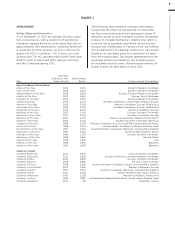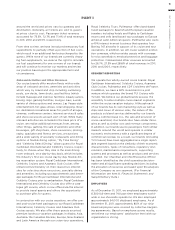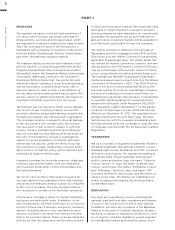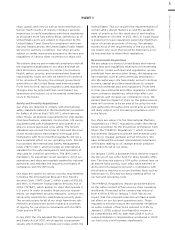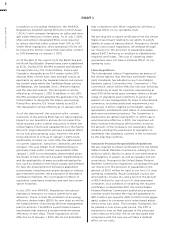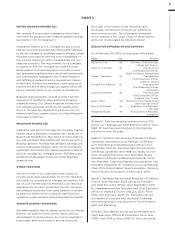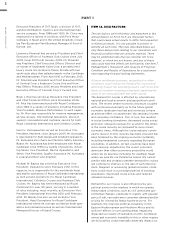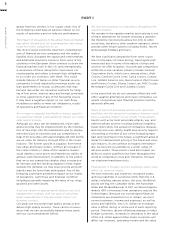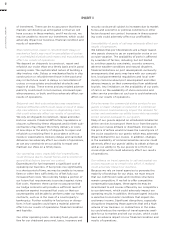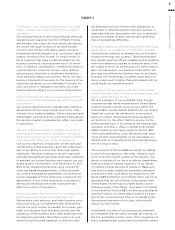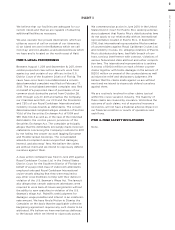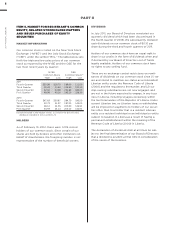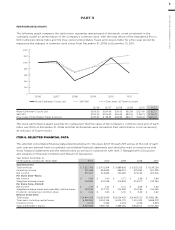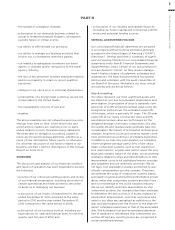Royal Caribbean Cruise Lines 2011 Annual Report Download - page 33
Download and view the complete annual report
Please find page 33 of the 2011 Royal Caribbean Cruise Lines annual report below. You can navigate through the pages in the report by either clicking on the pages listed below, or by using the keyword search tool below to find specific information within the annual report.
PART I
ROYAL CARIBBEAN CRUISES LTD. 29
operating results, cash flows and financial condition
including potentially impairing the value of our ships,
goodwill and other assets.
We may not be able to obtain sufficient financing or
capital for our needs or may not be able to do so
on terms that are acceptable or consistent with our
expectations.
To fund our capital expenditures and scheduled debt
payments, we have historically relied on a combination
of cash flows provided by operations, drawdowns
under available credit facilities, the incurrence of
additional indebtedness and the sale of equity or debt
securities in private or public securities markets. The
decrease in consumer cruise spending as a result of
the recent severe economic downturn had an adverse
impact on our cash flows from operations and if the
current economic conditions worsen our operational
cash flows could continue to be negatively affected.
See “−Adverse worldwide economic and geopolitical
conditions could reduce the demand for cruises and
adversely impact our operating results, cash flows and
financial condition.”
Although we believe we have or can access sufficient
liquidity to fund our operations and obligations as
expected, there can be no assurances to that effect.
Our ability to timely refinance and/or replace our
outstanding debt securities and credit facilities on
acceptable terms, our cost of funding and our ability
to access additional funding, as may be needed, will
depend upon numerous factors including but not
limited to the vibrancy of the financial markets, our
financial performance and credit ratings and the
performance of our industry in general.
Our inability to satisfy the covenants required by our
credit facilities would adversely impact our liquidity.
Our debt agreements contain covenants, including
covenants restricting our ability to take certain actions
and financial covenants that require us to maintain
minimum net worth and fixed charge coverage ratios
and limit our net debt-to-capital ratio. Our ability to
comply with the terms of our outstanding facilities may
be affected by general economic conditions, industry
conditions and other events, some of which may be
beyond our control. In addition, our ability to make
draws under our revolving credit facilities is subject
to the absence of material adverse changes in our
business. Our ability to maintain our credit facilities
may also be impacted by changes in our ownership
base. More specifically, we may be required to prepay
a majority of our debt facilities if (i) any person other
than A. Wilhelmsen AS. and Cruise Associates and
their respective affiliates (the “Applicable Group”)
acquires ownership of more than 30% of our common
stock and the Applicable Group owns less of our com-
mon stock than such person or (ii) subject to certain
exceptions, during any 24-month period, a majority of
the Board is no longer comprised of individuals who
were members of the Board on the first day of such
period. Certain of our outstanding debt securities
also contain change of control provisions that would
be triggered by the acquisition of greater than 50%
of our common stock by a person other than a mem-
ber of the Applicable Group coupled with a ratings
downgrade.
Our failure to comply with the terms of our debt facili-
ties could result in an event of default. Generally, if
an event of default under any debt agreement occurs,
then pursuant to cross default acceleration clauses,
our outstanding debt and derivative contract pay-
ables could become due and/or terminated. We can-
not provide assurances that we would have sufficient
liquidity to repay or refinance the borrowings under
any of the credit facilities or settle other outstanding
contracts if such amounts were accelerated upon an
event of default.
In addition, under several of our agreements with
credit card processors that accept credit cards for the
sale of cruises and other services, the credit card pro-
cessor may hold back a reserve from our credit card
receivables following the occurrence of certain events,
including a default under our major credit facilities.
As of December 31, 2011, we were not required to
maintain any reserve under such agreements.
Incidents or adverse publicity concerning the cruise
vacation industry, unusual weather conditions and
other natural disasters or disruptions could affect
our reputation as well as impact our sales and results
of operations.
The operation of cruise ships, airplanes, land tours,
port facilities and shore excursions involves the risk
of accidents, illnesses, environmental incidents and
other incidents which may bring into question guest
safety, health, security and vacation satisfaction which
could negatively impact our reputation. Incidents
involving cruise ships, and, in particular the safety
and security of guests and crew, such as the recent
grounding of the Costa Concordia, media coverage
thereof, as well as adverse media publicity concerning
the cruise vacation industry or unusual weather pat-
terns or natural disasters or disruptions, such as hurri-
canes and earthquakes, and the collateral impact
thereof could impact demand for our cruises. The
considerable expansion in the use of social media
over recent years has compounded the potential
scope of the negative publicity that could be gener-
ated by those incidents. If any such incident occurs in
a region during a time of high seasonal demand, the
effect could disproportionately impact our results of
operations for the year. In addition, any events which
impact the travel industry more generally may nega-
tively impact our ability to deliver guests to our cruises
and/or interrupt our ability to obtain services and


